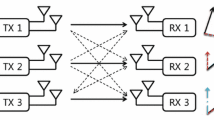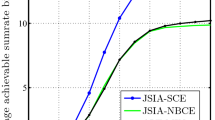Abstract
This chapter describes several aspects of the Interference Alignment (IA) technique with a focus on the spatial domain. The basic idea of Interference Alignment consists in precoding the transmitted signals such that they are aligned at the receiver where they constitute interference, while at the same time disjointed from the desired signal. This alignment limits the generated interference to a subspace at each receiver, which in turn leaves the remaining dimensions free from any interference. Most of the literature on IA considers an idealized scenario with perfect CSI available at the transmitter. In this chapter some well known IA algorithms from the literature are described, also with simulation results for this idealized scenario. Afterwards, some insights are provided on the impact of imperfections, where CSI error and transmit antenna correlation are included within the channel model. Finally, a systemic context is considered where IA is analyzed from a system-level point-of-view, for which some insights on complexity issues are also provided
Access this chapter
Tax calculation will be finalised at checkout
Purchases are for personal use only
Similar content being viewed by others
Notes
- 1.
There are different ways to calculate the chordal distance, but only the one described in (10.36) is here considered.
References
3GPP: Physical layer aspects for evolved Universal Terrestrial Radio Access (UTRA). Technical report TR 25.814 V7.1.0, 3GPP (2006)
3GPP: LTE channel models for concept evaluation in RAN1. Technical report R4–0.60101, 3\(^{rd}\) Generation Partnership Project, TSG-RAN Working Group 4 (2007)
3GPP: Spatial channel model for Multiple Input Multiple Output (MIMO) simulations. Technical report TR 25.996 V11.0.0, 3GPP (2012)
Aziz, D., Boccardi, F., Weber, A.: System-level performance study of interference alignment in cellular systems with base-station coordination. In: Proceedings of IEEE International Symposium on Personal Indoor and Mobile Radio Communications (PIMRC), pp. 1155–1160 (2012). doi:10.1109/PIMRC.2012.6362520
Cadambe, V.R., Jafar, S.A.: Interference alignment and degrees of freedom of the K user interference channel. IEEE Trans. Inf. Theory 54(8), 3425–3441 (2008). doi:10.1109/TIT.2008.926344. http://ieeexplore.ieee.org/lpdocs/epic03/wrapper.htm?arnumber=4567443
Cadambe, V.R., Jafar, S.A.: Interference alignment and spatial degrees of freedom for the \(K\) user interference channel. In: Proceedings of IEEE International Conference on Communications (ICC), pp. 971–975 (2008). doi:10.1109/ICC.2008.190
Ghasemi, A., Motahari, A.S., Khandani, A.K.: Interference alignment for the \(K\) user MIMO interference channel. In: Proceedings of IEEE International Symposium on Information Theory (ISIT), pp. 360–364 (2010). doi:10.1109/ISIT.2010.5513347
Gomadam, K., Cadambe, V., Jafar, S.: Approaching the capacity of wireless networks through distributed interference alignment. In: Proceedings of IEEE Global Telecommunications Conference (GLOBECOM), pp. 1–6 (2008). doi:10.1109/GLOCOM.2008.ECP.817
Gou, T., Jafar, S.A.: Degrees of freedom of the \(K\) user \(M \times N\) MIMO interference channel. IEEE Trans. Inf. Theory 56, 6040–6057 (2010). doi: 10.1109/TIT.2010.2080830
Huang, H., Papadias, C.B., Venkatesan, S.: MIMO Communications for Cellular Networks. Springer, New York (2011)
Jafar, S.A.: Interference Alignment—A new Look at Signal Dimensions in a Communication Network, Foundations and Trends in Communications and Information Theory, vol. 7. Now Publishers Inc, Boston (2011)
Jafar, S.A., Fakhereddin, M.: Degrees of Freedom for the MIMO Interference Channel. IEEE Trans. Inf. Theory 53(7), 2637–2642 (2007). doi:10.1109/TIT.2007.899557. http://ieeexplore.ieee.org/lpdocs/epic03/wrapper.htm?arnumber=4252335
Jafar, S.A., Shamai, S.: Degrees of freedom region of the MIMO X channel. IEEE Trans. Inf. Theory 54(1), 151–170 (2008). doi:10.1109/TIT.2007.911262
Klotz, J., Sezgin, A.: Antenna selection criteria for interference alignment. In: Proceedings IEEE International Symposium on Personal Indoor and Mobile Radio Communications (PIMRC), pp. 527–531 (2010). doi:10.1109/PIMRC.2010.5671906
Love, D., Heath, R.: Limited feedback unitary precoding for spatial multiplexing systems. IEEE Trans. Inf. Theory 51(8), 2967–2976 (2005). doi:10.1109/TIT.2005.850152
Maddah-ali, M., Motahari, A.S., Khandani, A.K.: Signaling over MIMO multi-base systems: Combination of multi-access and broadcast schemes. In: IEEE International Symposium on Information Theory (ISIT), pp. 2104–2108 (2006). doi:10.1109/ISIT.2006.261922. http://ieeexplore.ieee.org/lpdocs/epic03/wrapper.htm?arnumber=4036340
Makouei, B.N., Andrews, J.G., Heath, R.W.: MIMO interference alignment over correlated channels with imperfect CSI. IEEE Trans. Signal Process. 59(6), 2783–2794 (2011). doi:10.1109/TSP.2011.2124458
Mungara, R., George, G., Lozano, A.: System-level performance of distributed cooperation. In: Proceedings of Asilomar Conference on Signals, Systems and Computers, pp. 1561–1565 (2012). doi:10.1109/ACSSC.2012.6489291
Ning, H., Ling, C., Leung, K.K.: Feasibility condition for interference alignment with diversity. IEEE Trans. Inf. Theory 57(5), 2902–2912 (2011)
Özcelik, H., Czink, N., Bonek, E.: What makes a good MIMO channel model? In: Proceedings of IEEE Vehicular Technology Conference (VTC), vol. 61, pp. 156–160 (2005). doi:10.1109/VETECS.2005.1543269
Peters, S.W., Heath, R.W.: Interference Alignment via Alternating Minimization. In: Proceedings of IEEE International Conference on Acoustics, Speech and Signal Processing (ICASSP), pp. 2445–2448 (2009). doi:10.1109/ICASSP.2009.4960116
Peters, S.W., Heath, R.W.: Cooperative algorithms for MIMO interference channels. IEEE Trans. Veh. Technol. 60(1), 206–218 (2011). http://arxiv.org/abs/1002.0424
Ruan, L., Lau, V., Win, M.: The feasibility conditions for interference alignment in MIMO networks. IEEE Trans. Signal Process. 61(8), 2066–2077 (2013). doi:10.1109/TSP.2013.2241056
Spencer, Q.H., Swindlehurst, A.L., Haardt, M.: Zero-forcing methods for downlink spatial multiplexing in multiuser MIMO channels. IEEE Trans. Signal Process. 52, 461–471 (2004)
Yetis, C.M., Gou, T., Jafar, S.A., Kayran, A.H.: On feasibility of interference alignment in MIMO interference networks. IEEE Trans. Signal Process. 58(9), 4771–4782 (2010). doi:10.1109/TSP.2010.2050480. http://ieeexplore.ieee.org/lpdocs/epic03/wrapper.htm?arnumber=5466114
Yoo, T., Jindal, N., Goldsmith, A.: Finite-rate feedback MIMO broadcast channels with a large number of users. In: Proceedings of IEEE International Symposium on Information Theory (ISIT), pp. 1214–1218 (2006). doi:10.1109/ISIT.2006.261998
Author information
Authors and Affiliations
Corresponding author
Editor information
Editors and Affiliations
Rights and permissions
Copyright information
© 2014 Springer Science+Business Media New York
About this chapter
Cite this chapter
Moreira, D.C., Normando, P.G., Bandeira, C.I.R., Freitas Jr., W.C., Silva, Y.C.B. (2014). Interference Alignment, Concepts and Algorithms for Wireless Systems. In: Cavalcanti, F. (eds) Resource Allocation and MIMO for 4G and Beyond. Springer, New York, NY. https://doi.org/10.1007/978-1-4614-8057-0_10
Download citation
DOI: https://doi.org/10.1007/978-1-4614-8057-0_10
Published:
Publisher Name: Springer, New York, NY
Print ISBN: 978-1-4614-8056-3
Online ISBN: 978-1-4614-8057-0
eBook Packages: EngineeringEngineering (R0)




